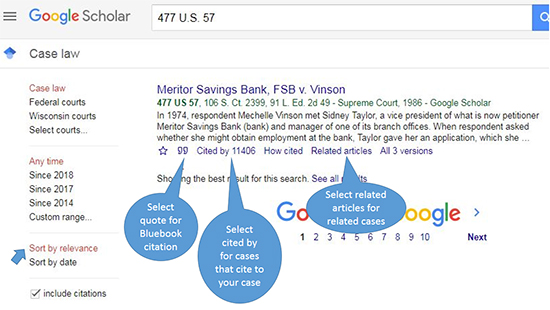
Oct. 3, 2018 – Sexual harassment allegations are repeatedly making today’s headlines, including with hashtags such as #Metoo and #Timesup, and as celebrity news, like the recent sentencing of Bill Cosby and the confirmation hearings of Judge Brett Kavanaugh. Harassment is being reported across institutions, from Hollywood to Washington, D.C., and the legal profession is not exempt.
 Genevieve Zook is the reference & instructional services librarian at the U.W. Law Library. She is currently chair of the Public Relations Committee and past president of the Law Librarians Association of Wisconsin, a chapter of the American Association of Law Libraries.
Genevieve Zook is the reference & instructional services librarian at the U.W. Law Library. She is currently chair of the Public Relations Committee and past president of the Law Librarians Association of Wisconsin, a chapter of the American Association of Law Libraries.
The potential damage and disruption a harassment lawsuit can cause to a company’s reputation as well as to their finances has not gone unnoticed by employers. Companies and institutions are taking a renewed interest in reviewing their employer anti-harassment policies, revising their handbooks and manuals, and offering sensitivity training to staff and management.
This guide is an introduction to resources useful when researching compliance, employer liability, and harassment claims in the workplace. It includes links to free or cost-effective legal resources, such as federal and state laws, regulations, significant case law, secondary resources, forms, surveys, and statistics.
Wisconsin State Law Library Resources
State Bar members and their staff are eligible for a library card and may borrow materials from the Wisconsin State Law Library. There you will find links to research tools, including:
-
The guide, Harassment in the Workplace, with useful links to legal resources on harassment and sex discrimination.
-
The Articles & Journals and Legal Databases website, which contains links to tools for legal search and analysis, including scholarly law review articles using the powerhouse legal journal and periodical databases HeinOnline and Index to Legal Periodicals (ILP).
-
Tips and video tutorials on how to use these databases are included on the right side of the page, where you’ll find links to law review articles on sexual harassment.
Federal Law Resources and Regulations
Some Historic Cases – Research via Google Scholar
You can search for law review articles using Google Scholar. While it is not as powerful as a subscription-based service for legal research, Google Scholar provides some valuable citation and search features for free. See below for research tips.
· Meritor Savings Bank, FSB v. Vinson1, 1986, was the first Title VII case before the U.S. Supreme Court, which held that unwelcome advances create a hostile work environment.
· In Harris v. Forklift Systems, Inc.2, 1993, the Court expanded the definition of a hostile work environment.
· In Oncale v. Sundowner Offshore Services, Inc.3, 1998, the Court held that same-sex harassment is actionable under Title VII.
· In Burlington N.. & SFR CO. v. White4, 2006, the Court defined adverse employment action and established an affirmative defense where there is no adverse employment action.
· Faragher v. Boca Raton5 and Burlington Industries, Inc. v. Ellerth6, two 1998 cases and often held together, set a stringent standard of vicarious liability on the part of the employer.
Navigation Tips in Google Scholar
When researching cases on Google Scholar, look under the case summary for links to expand or refine your search. See this example:

-
To see cases that cite to your target case, select the “cited by” tab link below the case summary. In the example above, 477 U.S. 57 has been cited 11,406 times. On the left side of the screen, you can restrict by jurisdiction or by date.
-
To see cases similar to your target case, put the name of the judge in the menu box and select “related articles.” Although Google Scholar doesn’t use legal terminology in a field search, if you know that “related articles” will retrieve case law and not articles then you can use this link to search for case law relevant to your case.
-
For a Bluebook citation of the case, select the quotes icon under the case’s summary.
Books and Articles
-
Investigation of the Workplace Harassment Claim – A practical guidebook that includes information on conducting an investigation and the essentials of a harassment claim.
-
Litigating the Workplace Harassment Case – This book thoroughly covers litigation involving workplace harassment.
-
Harassment in the Workplace – This link provides a downloadable PDF of a white paper presented at the American Law Institute – American Bar Association continuing legal education seminar, July 29, 2004. This white paper is a solid overview of case law and elements of a claim, and includes a 50 state survey of discrimination and harassment laws. Although a bit dated, it can be updated with other resources available in this guide.
Organizational Resources
Useful Resources and Recent Surveys
-
ABA Rule 8.4(g) Code of Professional Conduct – This professional conduct code covers rules on sexual harassment.
-
15 Key Steps for Companies Responding to Sexual Harassment or Discrimination Allegations – A Nov. 13, 2017, Forbes article with advice on responding to a claim of harassment. Provides a checklist of steps for clients.
-
Workplace Study by the ABA and the Working Mother Research Institute – These two organizations recently released the results of a March 2018 survey on harassment in the legal profession. The ABA also held a sexual harassment workshop. In the survey, 68 percent of women – legal professionals – said they experienced sexual harassment on the job. The study further suggests that women in the legal profession are still underreporting cases of sexual harassment.
-
Workplace Harassment a Common Problem, Survey of Milwaukee Businesswomen Shows – According to this BizTimes Jan. 8, 2018, article on a workplace harassment survey of professional Milwaukee businesswomen, 68 percent of respondents experienced sexual harassment in the workplace. “The women described switching job duties, quitting jobs, skipping work trips, and experiencing negative financial ramifications as a result of these incidents,” according to the article.
-
The EEOC maintains a table of sexual harassment statistics.
-
2018 survey of the #Metoo movement conducted in January 2018 by Stop the Street Harassment organization. According to the survey, “nationwide, 81 percent of women and 43 percent of men said they experienced some form of sexual harassment and/or assault in their lifetime.”
Sample Policies
A good policy cuts down on harassment claims and shows that a company is respectful of its workforce.
Here are two examples:
Related Reading and CLE Seminars
-
“#MeToo Marks a Changing Tide for Employers,” Wisconsin Lawyer magazine, Sept. 2018
-
“New Tax Law Creates Barriers for Sexual Harassment Claims,” InsideTrack, Jan. 17, 2018
-
Sexual Harassment in the Workplace, State Bar PINNACLE® OnDemand CLE seminar
-
#MeToo: Investigating and Addressing Claims of Sexual Harassment in the Workplace, Webcast Replay CLE program from Health, Labor, & Employment Law Institute, August 2018
-
Identifying and Preventing Workplace Sexual Harassment in the Wake of #MeToo – 2018, State Bar PINNACLE® OnDemand CLE seminar
Endnotes
1 106 S. Ct. 2399, 91 L. Ed. 2d 49 (1986).
2 510 U.S. 17, 114 S. Ct. 367, 126 L. Ed. 2d 295 (1993).
3 523 U.S. 75, 118 S. Ct. 998, 140 L. Ed. 2d 201 (1998).
4 547 U.S., 126 S. Ct. 2405, 165 L. Ed. 2d 345 (2006).
5 524 U.S. 775, 118 S. Ct. 2275, 141 L. Ed. 2d 662 (1998).
6 524 U.S. 742, 118 S. Ct. 2257, 141 L. Ed. 2d 633 (1998).
